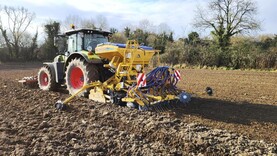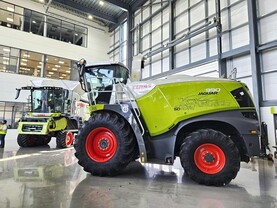Claas has developed the unique Dynamic Power system for its self-propelled silage harvesters. This was originally just available on the highest powered Jaguar 980 and 970 models. It has now been extended to the Jaguar 960, 950 and 940 Tier 4i models and is now also available on the latest Jaguar 870 and 860 models.
Dynamic Power controls the amount of power required by the machine at any one time. It is also claimed to reduce the overall fuel consumption of the harvester.
Claas and the German research organisation, the DLG, have carried out a number of trials to highlight this feature. Claas also claims that customer experience has further verified the advantages of this system.
How does it work?
Dynamic Power enables the engine to recognise varying crop conditions, and responds to this by reducing the amount of power required when necessary. As the load on the engine varies, for example when working in lighter crops or in lower yielding parts of a field, the engine management system automatically recognises this. It will alter the engine power output accordingly, over 10 power steps.
The engine will automatically change power output as the load on the engine changes. Claas claims that this will ensure that the engine can maintain its optimum speed of 1,800rpm, when it will be at its most economical, so saving a considerable amount of fuel.
In trials conducted by the DLG comparing the difference in fuel consumption on a standard Tier 4i 653hp Jaguar 960, it found that, when Dynamic Power was engaged, fuel consumption was reduced by a significant 12.3%. This was not at the expense of output, which dropped by just two tonnes per hour.
The trial was conducted in Germany on third cut silage, yielding on average 3.41 tonnes dry weight/hectare with an average DM of 31.3%. The chop length on the forager was set at 22mm and the accelerator at 4mm.
The Claas Jaguar was operated using Cruise Pilot to maintain a consistent speed. The Dynamic Power was engaged on every other row to ensure comparable conditions across the harvested area.
In all, some 457 tonnes of grass was harvested, at an average speed on 11km/h and, when engaged, Dynamic Power ranged between power level 2 (348hp) and level 5 (463hp).
As can be seen from Table 1, by using Dynamic Power, the trial found that overall fuel consumption was reduced by 12.3%, while Ad Blue consumption remained at about 5%, but the hourly throughput dropped by less than a trailer load.
Tier 3 vs Tier 4i
The efficiency and greater output that a Tier 4i-powered Jaguar can achieve has been highlighted in another trial conducted by the DLG. This trial compared a Tier 3 powered 653hp Jaguar 960 with the latest Tier 4i powered 598hp Jaguar 950.
In the trials, both machines harvested 740 tonnes of maize using Claas Orbis S 750 headers in a crop with an average yield of 30t/ha and dry matter ranging from 29.5% to 57.7%. Both machines were set up the same, with the chop length set at 8mm, the cracker clearance was 1.8mm with a 30% difference in speed between each roller and tyre pressures at 1.2 bar. As can be seen from Table 2, over the 740 tonnes harvested by each machine, in terms of straight output, the Jaguar 950 was only fractionally behind the higher powered Jaguar 960.
However, where the Jaguar 950 had the edge was in fuel consumption, using nearly 5.6% less fuel than the Jaguar 960, with AdBlue accounting for just 0.032 litres/tonne, just 4.7% of fuel consumption.






 This is a subscriber-only article
This is a subscriber-only article










SHARING OPTIONS: